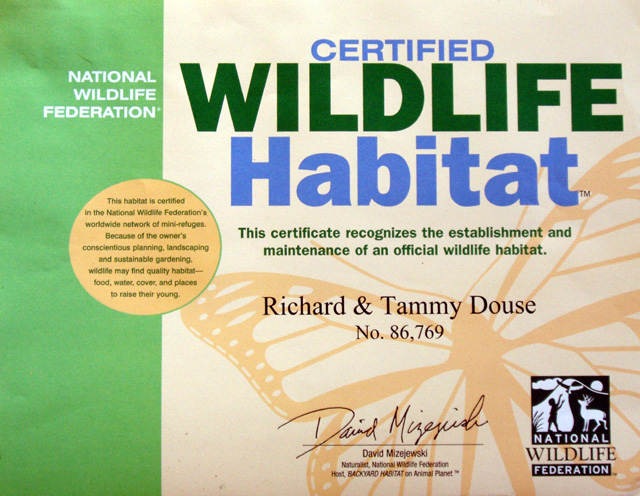
This is the story of how Richard and Tammy Douse came to live off-grid, and have been producing their own electricity and collecting rainwater off their house roof since 1998, while enjoying all the conveniences of modern living.
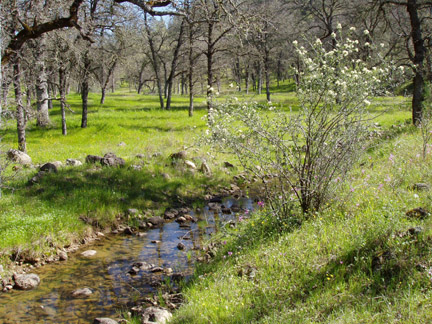
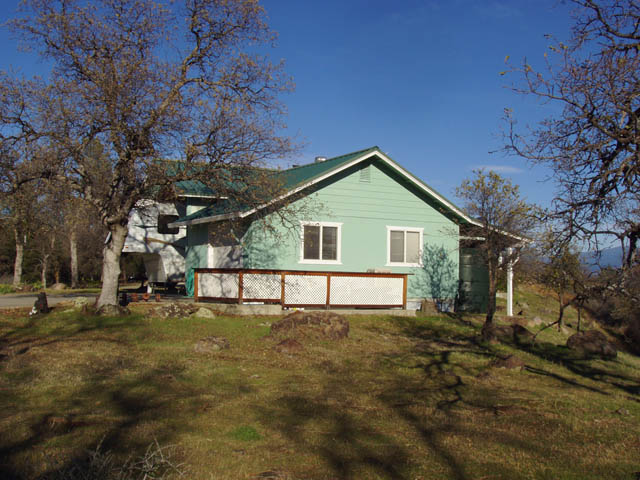

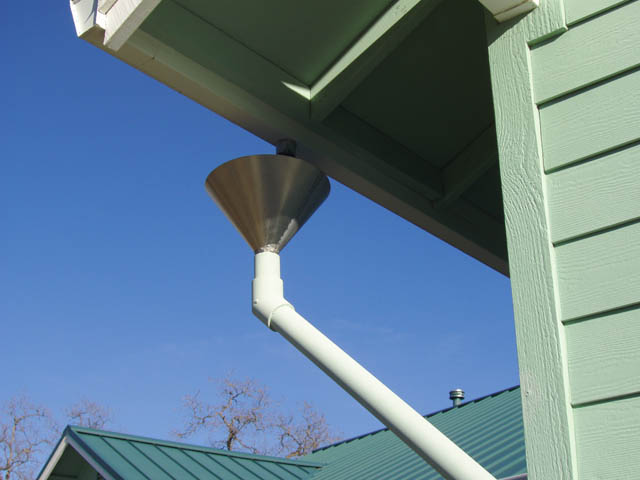
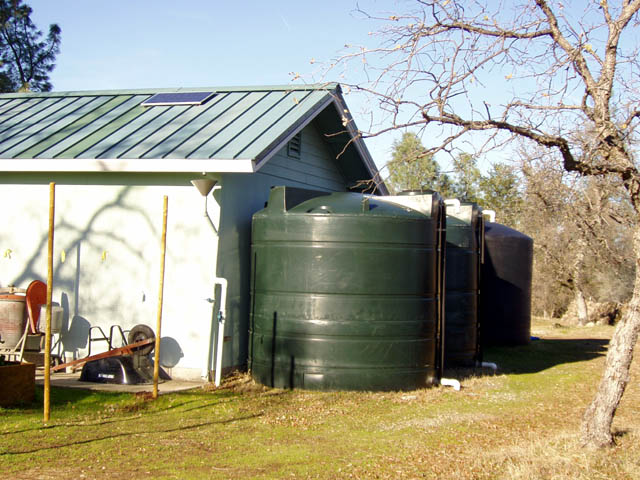
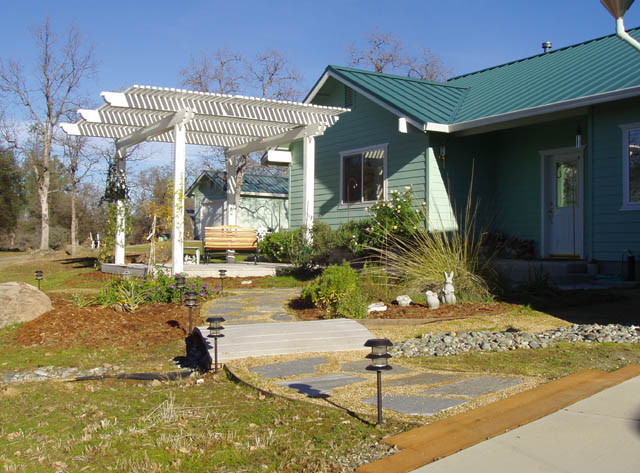
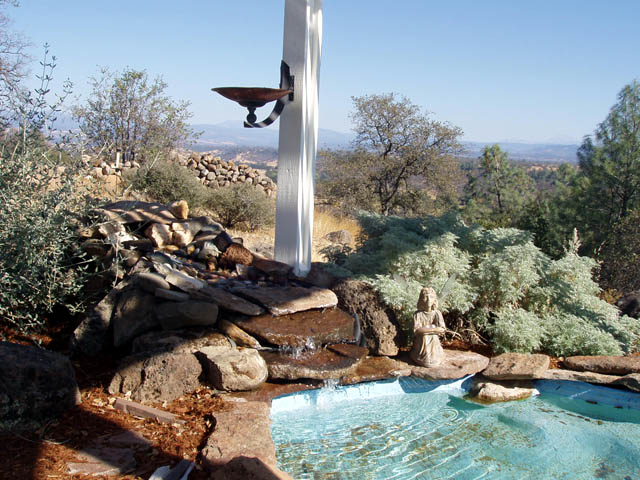
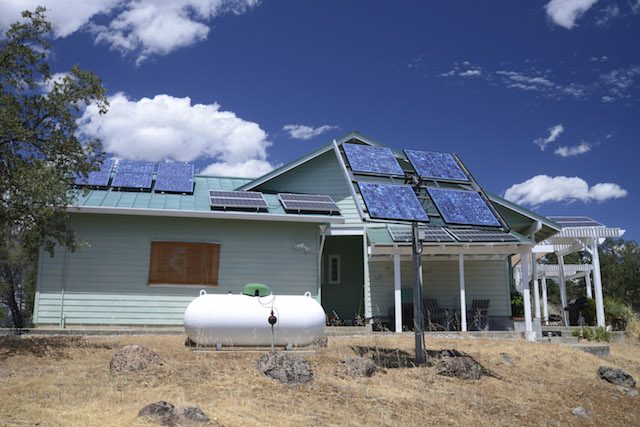
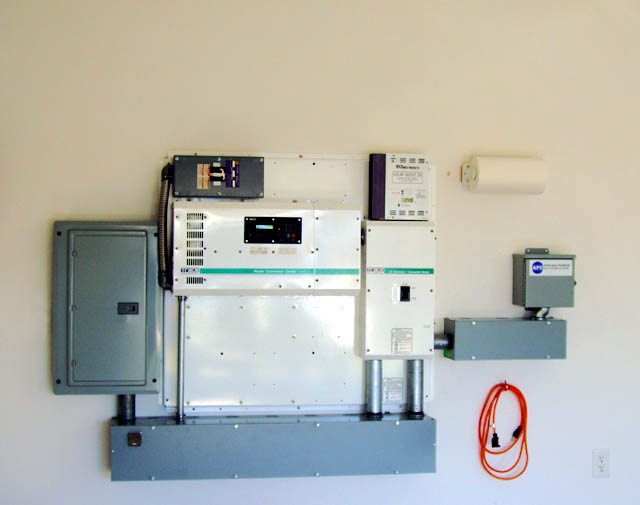
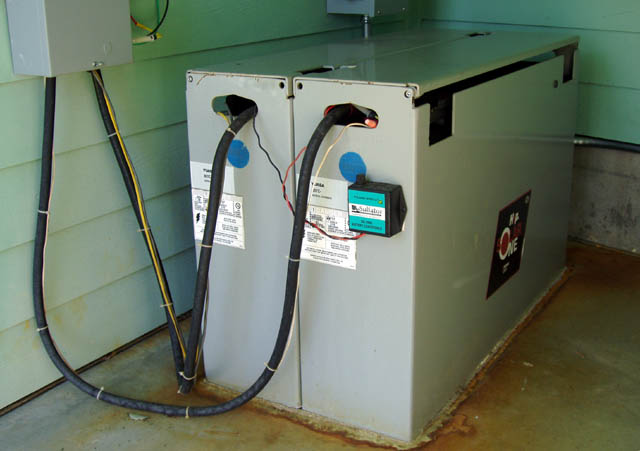
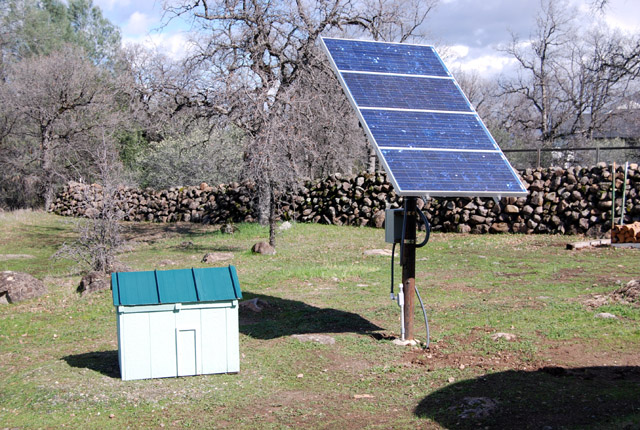
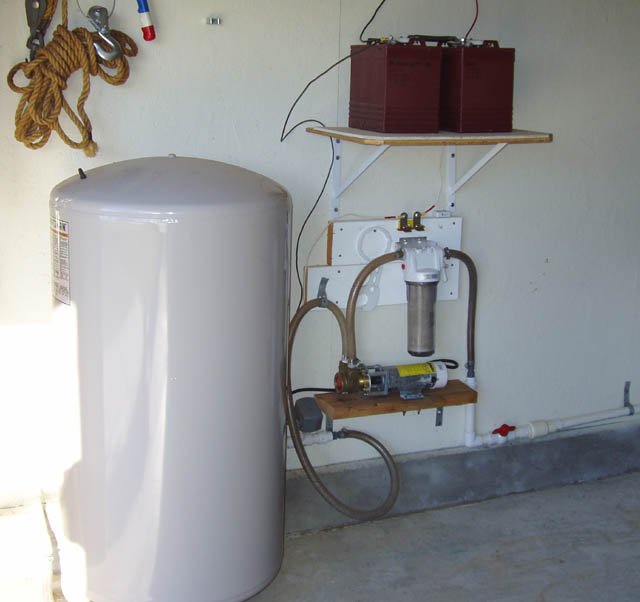
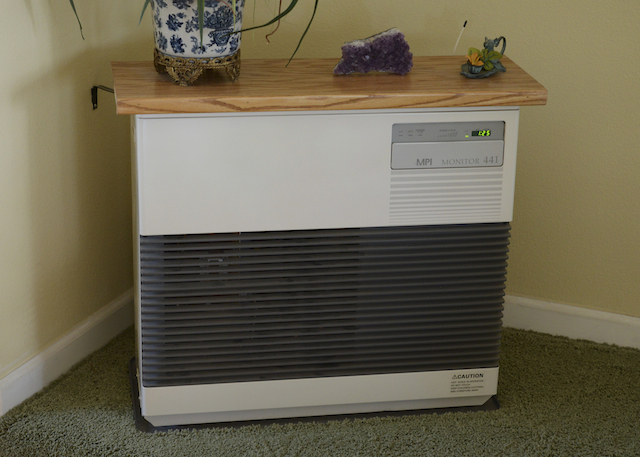
The Property
Our home that we now call "Rocky Top" is a 38 acre parcel of land about a half hours drive east of Redding, California. It consists of a long ridge as well as a valley with a little winter creek running through the middle.
The first challenge was solving the percolation problem. It had been assumed, correctly, that the best building site was up on the top of the ridge that offered a sweeping view of Mount Lassen and the surrounding area. Because of this, the percolation test was done on top of the ridge. However, far down in the valley, we were able to find suitable soil that passed inspection. We then, literally, "jack-hammered" a hole for the septic tank on the building site and ran 2 inch PVC pipe down to a leach field, 600 feet away and 200 feet below! With this problem solved, we were able to get a permit to build.
My wife and I both enjoy building and together we first built a garage-shop-RV port which we then moved into, using our 5th wheel trailer as our kitchen, pantry, and bathroom. The garage/shop became our living room and bedroom. This would be our home for the two and a half years that it would take for us to build our house.
To see if we could live "off the grid" using photovoltaic panels and batteries, we bought two ancient (1980 vintage) 110 watt panels and hooked them up to a 1500 watt inverter to convert the direct current (12 volt DC) power to normal alternating current (120 volt AC), that would then run the washing machine, TV, and our computer.
Of course we would still need water and, at the time, drilling a 300 foot well seemed a too expensive. We were also concerned that the water might taste funny. Since we had been concerned about fire danger, we built our first building with an enameled steel roof. This roof would allow us the opportunity to collect rainwater that we could then store in tanks. If we were ever threatened by fire, we would have a large quantity of water on hand for fighting it.
This garage/RV port was our first home, our prototype. It was a test to see if these ideas were really doable. On completion of the garage/RV port, we installed three 2,300 gallon tanks behind it and under a roof. If you look closely you will see a stainless steel funnel under the rain gutter and 2" PVC pipe that runs straight down. This joins a kind of manifold which connects to all three tanks. The tanks, as it rains, fill from the bottom. As they fill, the pipe also fills as water seeks a common level. People ask if we get enough rain to fill these tanks. The formula is quite simple. For every 100 square feet of surface, one inch of rain will give you 60 gallons of water. This particular building will capture enough water to fill all three tanks with just 9 inches of rainfall! Unseen in this picture are our two 105 watt panels on the roof. These panels were first used in the Mohave ARCO project in the early 1980s are still working well. It is really hard to "wear out" a photovoltaic power panel as there are no moving parts, unless you count the electrons which are knocked out of their grid when hit by a photon from our sun! And then, while producing electric energy, they migrate back to where they were and the process repeats! Well, maybe not exactly like that, but that's the idea.
The first three tanks provided enough water to allow us to make it through our dry season while we were living in the garage/RV port. However, we knew we'd need more storage once we were living a more normal existence in a real house! So, when we built what would become the "tractor garage" we also installed more tanks. In this picture are two more 2,300 gallon tanks. Unseen are two 2,500 gallon tanks that are behind the building.
The "Main" house!
During all phases of construction, my wife and I were also both working full time at other jobs. Since we did almost everything ourselves, we would be living in the garage for two and a half years. From designing the plans to laying out string lines, we formed, poured concrete (with the help of dear friends!), did the rough plumbing, framing, siding, roof sheathing, and painting. Because our property is home to rattlesnakes, I decided I did not want to build on a raised foundation. Because of the grade and the multiple levels, the foundation and slab would take us the first year. Some things, of course, are best given to subcontractors. In our case, the topout plumbing, the sheet-rock, tile work, the AC electrical in the main house, all the cabinets, carpeting, and the oak flooring.
Building
electricity conservation into the house
construction
Since we had committed ourselves to living "off grid", we tried to incorporate as many energy saving features as we could think of. The house is 2x6 framed which allows for R-19 insulation in the walls. The exterior was first entirely wrapped with OSB before hanging the fire resistant Hardi plank siding. As our area, Shasta County, California, is well known for its industrial strength summers, we decided to vent the roof ridge by holding back the roof sheathing about four inches from the peak and then covering the gap with 1/8 inch screening. This was then covered by the metal roof cap that sits on top of the metal ridges of the roof. As a result, since hot air travels upwards naturally, the attic is vented very efficiently and passively. This helps maintain a relatively cool attic area that, in addition, has two feet of blown in insulation. This works to create a cooler ceiling so that when the temperature outside reaches over 110 degrees, we keep much of the coolness that was obtained the previous night. To bring in that late night and early morning coolness, we have installed a highly efficient whole house fan. When needed, we have ceiling fans in the bedrooms, living room, and study. Even on those days when the temperature is especially high, the inside our home stays in the mid 80s which, with the ceiling fans, is comfortable. However, to make things even more comfortable on especially hot days and nights when the temperature stays high, I installed a through-the-wall air conditioning unit this spring.
Electricity
The house is powered by photovoltaic panels which charge large industrial sized batteries wired for 24 volts DC. There are four BP® 120 watt panels on a Zomeworks® tracker. We also have six BP® 120 watt panels, six Sharp® 170 watt panels and six 185 watt Eoplly® panels facing south. Facing southeast are two BP® 150 watt panels We have a 4,000 watt inverter/charger which not only charges our batteries but converts the electricity obtained from these sources to 120 volts AC as needed. We also have an Onan® generator that runs on propane, but this does not see any use from April until some time in November when our rainy season begins.
The RV/garage now has two 80 watt panels that charge two golf cart batteries that supply 12 volts DC to the pump that pressurizes our rainwater as well as supplying juice for a 1500 watt inverter that runs our shop tools.
A little 50 watt panel on the pergola over the pond runs the pond pump that gives us a waterfall whenever the sun is shining.
Since we have learned that you can't really grow vegetables on stored rainwater, we invested in a 300 foot well. The well pump is a Lorentz® and is run by four BP® 80 watt panels. This water flows to a 2500 gallon tank that is separate from our rainwater system. This water is pressurized by another pump that gets its power from two golf cart batteries that are charged from a two 50 watt panels on the tractor garage roof.
After enjoying some success gardening in raised beds up on our ridge, we decided to garden more extensively down in our valley. We had a 80 foot well drilled and then installed a 24 volt Shurflo® 9300 submersible pump, powered by the two ancient 110 watt panels we had on the garage/RV port when we began our project. This pump pulls water up out of the well and pushes it up a hill to a 2500 gallon water tank.
Most men would agree that a man can't have too many garages, and now you see that, if you live off-grid, you can't have too many photovoltaic panels either!
Heating, and other
energy saving devices
For heating our home we have a Monitor® kerosene heater which is extremely efficient. It only uses about 70 gallons of kerosene a year! We also have a small wood stove for back up heating. Our refrigerator is perhaps the best you can get for off grid solar living. It is called Sunfrost® and when they say it saves electricity by a factor of five, you can believe it. It does. If every family in the United States had one of these in their home we wouldn't need foreign oil! We have the big model, the RF19 (refrigerator/freezer) in 24 volts DC, but it can be purchased in conventional AC also. For washing clothes we have a System 2000® horizontal axis top loader. Very efficient. It uses very little water and electricity without sacrificing cleaning ability. For water heating we have an AquaStar® on demand heater. It's great. When you turn on the faucet you get hot water instantly. When you close the faucet you are no longer heating water, only the pilot light is on. We do spend some on propane, mostly in the winter when we're socked in and have to run our Onan® 5500 watt generator for a couple of hours per day to top off the batteries. And, we use propane in the kitchen
And now . . . to answer the most often
asked question,
"If I invest in solar power, when will I get my money back?"
"If I invest in solar power, when will I get my money back?"
This question should be the easy to answer, but all the so-called experts struggle with it. They go into complicated mathematical exercises that only serve to confuse people. Let's not do that here. Let me keep it simple.
Solar power installed on your home is an "investment." It is similar to other highly secure investments such as a certificate of deposit, commonly called a "CD." With the purchase of a solar system, either on grid or off, or with the purchase of a CD, you will lose direct control of your money while the investment is working for you. The solar system is working by saving you the expense of conventional electricity. That is, in effect, paying you money by not requiring that you spend it. The CD is paying you money in interest. What you are receiving from both of these investments are a return ON your money. This return on your investment begins to accrue, in both cases, immediately! The return will continue as long as you hold (or renew) the investment.
With an investment such as a CD, you will receive a return OF your investment when you cash it in at the end of its term. Likewise, you will receive a return OF your solar system investment when you sell your house. At that point you will no longer be an investor. You will have your money back. But keep in mind this important fact. While an investment such as a CD will give you a fixed return, with an investment in a photovoltaic system, your percentage of return can only increase as the cost of "store bought" electricity goes up over the years.
I hope the information given above is helpful to those of you who are thinking of "going solar" and have been reluctant to take the first step. I hope you will do that. It is one of the most important things you can do for your country and our planet. If you should have any questions, send me an email and I'll try and answer